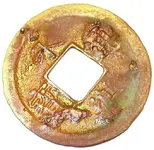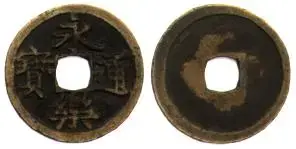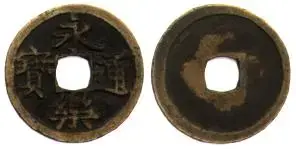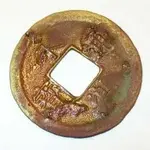Re: HOLY COW my oldest coin to date (1408-1424 A.D)
Emperor Yung Lo issued Yung Lo T'ung Pao in the sixth year of the Yung Lo reign (AD1408).
The rareness is noted as "E" but I didn't find that definition quickly scanning the site.
Don.......
Source:
http://ykleungn.tripod.com/mingcoin.htm
Report to moderators (good or bad!) Logged
imafishingnutt
Charter Member
Hero Member
Online
Posts: 1116
GRRRRR THIS AINT NO FISHINGNUTT
Depoe Bay Oregon
Detector used: XLT
RUNNING TOTALS: 2008
Quarters: 5
Dimes: 17
Nickels: 9
Pennies: 79
Tokens: 1
Non-US Coins: 1 A 1424 AD Cash coin
Wheat Pennies: 1
Other Silver Coins: 1
Gold Items: 1
Silver Items: 1
Keys: 5
Re: coin ID help i found it with MD UPDATE HOLY COW
« Reply To This Topic #2 on: Yesterday at 09:44:41 PM » Quote Modify Remove
--------------------------------------------------------------------------------
Thats very intersting heres what I read.
Now ill try to see what rare E meens
yung Lo T'ung Pao (1408-1424)
Chu Ti (Ming Cheng Tsu), the fourth son of Emperor T'ai Tsu became the Emperor of Ming empire in 1402. He used Yung Lo as his reign and transferred the capital to Peking from Nanking.
Yung Lo Emperor revived the Ming navy by dispatching a great fleet to visit countries in South-East Asia and the Indian Ocean. A shipyard was built at the new capital of Nanking and also a school for training foreign languages was established by the Yung Lo Emperor.
In 1405, the Ming Emperor sent Cheng Ho (Zheng He) [1371-1435] as commander to started his first voyages with 62 large ships, 4 of them were approximately 138 meters long and 56 meters wide. They were the largest ships ever built in history. The Ming fleet was embarked with abount 28,000 men. The ships were filled with many Chinese goods for trading with other countries during the voyage. Cheng Ho, a Muslim from Yunnan province, who proved an excellent envoy with his great seaborne expeditions, he even reached as far as the east coast of Africa.
Emperor Yung Lo issued Yung Lo T'ung Pao in the sixth year of the Yung Lo reign (AD1408), but only limited numbers minted sporadically.
Together with the development of foreign trade, many of the Hung Wu and Yung Lo cash coins were transpored to Japan from China following the maritime trade of the three provinces of Kwangtung, Chekiang and Fukien.
On the other hand, at the end of the 10th century, the power of the Japanese government weakened, so the Japanese government suspended the mintage of coins. During the middle of the 12th century, the Japanese Heian government did not cast cash coins. The Japanese government officially allowed people to use Chinese coins for the local market in 1226, so that various kinds of Chinese coin (mainly including coins of Sung and Ming Dynasty) imported from China were used as money in Japan until the Edo Period (1636) [some of the Chinese scholars believe that the latter date is 1670]. The imported Chinese coins were known as "Toraisen" in Japan. Nowadays we still find Chinese coins easily in Japan













 Freaking old, common, worth a few bucks. Very nice.
Freaking old, common, worth a few bucks. Very nice.